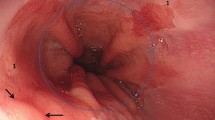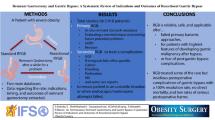Abstract
Background
Esophageal reflux symptom has been reported as common in patients with subtotal gastrectomy. Management of postoperative esophageal reflux symptom is not satisfactory. The aim of this study is to investigate prevalence of esophageal reflux symptom after subtotal gastrectomy and assess factors affecting esophageal reflux symptom in subtotal gastrectomy patients.
Methods
We prospectively enrolled 100 consecutive patients with subtotal gastrectomy who were regularly followed up by endoscopic examination. Acid secretory capacity was assessed by measuring messenger RNA (mRNA) expression of H+/K+-adenosine triphosphatase (ATPase) via real-time polymerase chain reaction (PCR) in biopsy specimens.
Results
In total, 47 % of patients had typical esophageal reflux symptom, where heartburn or regurgitation was experienced at least weekly. Age, sex, body mass index, and type of reconstruction did not differ between esophageal reflux and non-esophageal-reflux groups. The esophageal reflux group had longer duration from time of operation until study (median 5.0 versus 3.6 years; P = 0.017). Hill grade for gastroesophageal (GE) flap valve was higher in the esophageal reflux group than in the non-esophageal-reflux group (P = 0.027). H+/K+-ATPase mRNA expression was higher in the esophageal reflux group than in the non-esophageal-reflux group [3967.6 (± 7583.7) versus 896.2 (± 1456.0); P = 0.006]. Multivariate analysis revealed that postoperative duration, H+/K+-ATPase mRNA expression level, and GE flap valve disruption were significantly associated with esophageal reflux symptom development.
Conclusions
Esophageal reflux symptom is common in patients after subtotal gastrectomy, possibly because of anti-reflux-barrier impairment and preservation of acid secretory capacity following surgery. Optimal acid suppression may be helpful in managing postoperative esophageal reflux symptom.



Similar content being viewed by others
References
Morii Y, Arita T, Shimoda K, et al. Jejunal interposition to prevent postgastrectomy syndromes. Br J Surg. 2000;87:1576–1579.
Lundell L. Acid secretion and gastric surgery. Dig Dis. 2011;29:487–490.
Im MH, Kim JW, Kim WS, et al. The impact of esophageal reflux-induced symptoms on quality of life after gastrectomy in patients with gastric cancer. J Gastric Cancer. 2014;14:15–22.
Yuasa N, Abe T, Sasaki E, Fukaya M, Nimura Y, Miyahara R. Comparison of gastroesophageal reflux in 100 patients with or without prior gastroesophageal surgery. J Gastroenterol. 2009;44:650–658.
Kim JW, Yoon H, Kong SH, et al. Analysis of esophageal reflux after proximal gastrectomy measured by wireless ambulatory 24-hr esophageal pH monitoring and TC-99 m diisopropyliminodiacetic acid (DISIDA) scan. J Surg Oncol. 2010;101:626–633.
Herbella FA, Vicentine FP, Del Grande JC, Patti MG, Arasaki CH. Postprandial proximal gastric acid pocket in patients after Roux-en-Y gastric bypass. J Gastrointest Surg. 2010;14:1742–1745.
Herbella F, Vicentine F, Silva L, Patti M. Postprandial proximal gastric acid pocket in patients after distal gastrectomy. Neurogastroenterol Motil. 2011;23:1081–1083.
Sears RJ, Champion GL, Richter JE. Characteristics of distal partial gastrectomy patients with esophageal symptoms of duodenogastric reflux. Am J Gastroenterol. 1995;90:211–215.
Wyrwich KW, Mody R, Larsen LM, Lee M, Harnam N, Revicki DA. Validation of the PAGI-SYM and PAGI-QOL among healing and maintenance of erosive esophagitis clinical trial participants. Qual Life Res. 2010;19:551–564.
Chan Y, Ching JY, Cheung CM, et al. Development and validation of a disease-specific quality of life questionnaire for gastro-oesophageal reflux disease: the GERD-QOL questionnaire. Aliment Pharmacol Ther. 2010;31:452–460.
Wiklund I, Carlsson J, Vakil N. Gastroesophageal reflux symptoms and well-being in a random sample of the general population of a Swedish community. Am J Gastroenterol. 2006;101:18–28.
Vakil N, van Zanten SV, Kahrilas P, Dent J, Jones R. The Montreal definition and classification of gastroesophageal reflux disease: a global evidence-based consensus. Am J Gastroenterol. 2006;101:1900–1920. (quiz 1943).
Lundell LR, Dent J, Bennett JR, et al. Endoscopic assessment of oesophagitis: clinical and functional correlates and further validation of the Los Angeles classification. Gut. 1999;45:172–180.
Hill LD, Kozarek RA, Kraemer SJ, et al. The gastroesophageal flap valve: in vitro and in vivo observations. Gastrointest Endosc. 1996;44:541–547.
Kubo M, Sasako M, Gotoda T, et al. Endoscopic evaluation of the remnant stomach after gastrectomy: proposal for a new classification. Gastric Cancer. 2002;5:83–89.
Schmittgen TD, Livak KJ. Analyzing real-time PCR data by the comparative CT method. Nat Protoc. 2008;3:1101–1108.
Wallmark B, Larsson H, Humble L. The relationship between gastric acid secretion and gastric H+, K+-ATPase activity. J Biol Chem. 1985;260:13681–13684.
Fujiwara Y, Nakagawa K, Kusunoki M, Tanaka T, Yamamura T, Utsunomiya J. Gastroesophageal reflux after distal gastrectomy: possible significance of the angle of His. Am J Gastroenterol. 1998;93:11–15.
Fujiwara Y, Nakao K, Inoue T, et al. Clinical significance of hiatal hernia in the development of gastroesophageal reflux after distal gastrectomy for cancer of the stomach. J Gastroenterol Hepatol. 2006;21:1103–1107.
Herbella F, Vicentine F, Del Grande J, Patti M. Postprandial proximal gastric acid pocket and gastric pressure in patients after gastric surgery. Neurogastroenterol Motil. 2011;23:e52–e54.
Xiao YL, Peng S, Tao J, et al. Prevalence and symptom pattern of pathologic esophageal acid reflux in patients with functional dyspepsia based on the Rome III criteria. Am J Gastroenterol. 2010;105:2626–2631.
Tack J, Becher A, Mulligan C, Johnson DA. Systematic review: the burden of disruptive gastro-oesophageal reflux disease on health-related quality of life. Aliment Pharmacol Ther. 2012;35:1257–1266.
McColl KE, Clarke A, Seenan J. Acid pocket, hiatus hernia and acid reflux. Gut. 2010;59:430–431.
Kahrilas PJ, McColl K, Fox M, et al. The acid pocket: a target for treatment in reflux disease? Am J Gastroenterol. 2013;108:1058–1064.
Curcic J, Roy S, Schwizer A, et al. Abnormal structure and function of the esophagogastric junction and proximal stomach in gastroesophageal reflux disease. Am J Gastroenterol. 2014;109:658–667.
Iida F, Ishizaka K, Sugenoya A. Lower esophageal sphincter pressure after subtotal gastrectomy and postoperative reflux esophagitis. Hepatogastroenterology. 1994;41:581–584.
Chang FY, Yeh CL, Lu CL, et al. Preserved esophagogastric manometric motility in patients after distal gastrectomy. Hepatogastroenterology. 1999;46:2387–2392.
Shibata Y. Effect of semifundoplication with subtotal gastrectomy for prevention of postoperative gastroesophageal reflux. J Am Coll Surg. 2004;198:212–217.
Marcovechio Fonseca CA, Martinez JC, Piesciotto A, Yanagita ET, Denardin OV, Herani Filho B. Manometric study of the lower esophageal sphincter and esophagus in subtotal gastrectomy patients. Dis Esophagus. 2008;21:118–124.
Soumarmon A, Lewin MJ. Gastric (H+, K+)-ATPase. Biochimie. 1986;68:1287–1291.
Osawa H, Kita H, Ohnishi H, et al. Helicobacter pylori eradication induces marked increase in H+/K+-adenosine triphosphatase expression without altering parietal cell number in human gastric mucosa. Gut. 2006;55:152–157.
Jo HJ, Kim N, Nam RH, et al. The effect of cochinchina momordica seed extract on gastric acid secretion and morphologic change in aged rat stomach. Gut Liver. 2013;7:560–568.
Beaumont H, Bennink RJ, de Jong J, Boeckxstaens GE. The position of the acid pocket as a major risk factor for acidic reflux in healthy subjects and patients with GORD. Gut. 2010;59:441–451.
Leibur M, Kengsepp AT, Sibul U, Truve R. Effect of proximal gastric vagotomy on the activity of hydrogen, potassium-stimulated ATPase in the gastric mucosa of patients with duodenal ulcer. Eur J Surg. 1992;158:223–226.
Joffe SN, Crocket A, Doyle D. Morphologic and functional evidence of reinnervation of the gastric parietal cell mass after parietal cell vagotomy. Am J Surg. 1982;143:80–85.
Johnston D, Wilkinson AR, Humphrey CS, et al. Serial studies of gastric secretion in patients after highly selective (parietal cell) vagotomy without a drainage procedure for duodenal ulcer. I. Effect of highly selective vagotomy on basal and pentagastrin-stimulated maximal acid output. Gastroenterology. 1973;64:1–11.
Funding
This research was supported by the Basic Science Research Program through the National Research Foundation of Korea funded by the Ministry of Education, Science, and Technology (NRF-2013R1A1A2007985) and by the program of the Global Research and Development Center through the National Research Foundation of Korea funded by the Ministry of Science, ICT, and Future Planning (NRF-2011-0031644).
Author information
Authors and Affiliations
Contributions
All authors listed were involved in the study design and interpretation of data for the work. M.G. Choi, H.J. Oh, J.M. Park, and H.M. Yoo enrolled patients and collected clinical data. M.G. Choi, H.J. Oh, J.M. Park, and K.Y. Song finished the data analysis and manuscript writing. M.G. Choi and H.J. Oh created tables and figures. M.G. Choi supervised the study. All authors approved the final version of the manuscript.
Corresponding author
Ethics declarations
Conflict of Interest
The authors declare that they have no conflict of interest.
Ethical approval
All procedures followed were in accordance with the ethical standards of the responsible committee on human experimentation (institutional and national) and with the Declaration of Helsinki of 1964 and later versions.
Rights and permissions
About this article
Cite this article
Oh, H.J., Choi, MG., Park, J.M. et al. Acid Secretion and Its Relationship to Esophageal Reflux Symptom in Patients with Subtotal Gastrectomy. Dig Dis Sci 63, 703–712 (2018). https://doi.org/10.1007/s10620-018-4923-9
Received:
Accepted:
Published:
Issue Date:
DOI: https://doi.org/10.1007/s10620-018-4923-9




